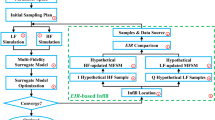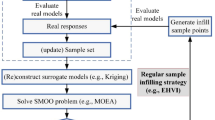Abstract
Surrogate models are widely used in simulation-based engineering design. The distribution of samples directly determines the quality and efficiency of surrogate models, which has a significant influence on follow-up work. This paper proposes a multipeak parallel adaptive infilling (MPEI) strategy based on expected improvement (EI), which can be divided into two stages: the construction of candidate peak areas and the selection of appropriate candidates at the candidate peak areas. In the first stage, the candidates are divided into the corresponding subspaces in sequence according to the value of EI and the position of each candidate to construct the candidate peak areas. In the second stage, the Gaussian function is used to extract the uncorrelated parent point and the corresponding offspring points in each candidate peak area. Based on these stages, the MPEI strategy selects multiple new samples in spaces with both local optima and areas of large uncertainty interest, which can fully balance global exploration and local exploitation. In addition, the samples selected in each candidate peak area are concise and locally uniform, which can effectively reduce the computational cost. Seven benchmark cases and one engineering problem are used to validate the performance of the MPEI strategy. The results show that the MPEI strategy can efficiently obtain the desired prediction accuracy of surrogate models at a small price of a few samples and confirm the feasibility and robustness of the presented methodology.


























Similar content being viewed by others
References
Boddy R, Smith G (2011) Effective experimentation: for scientists and technologists. John Wiley & Sons, Hoboken
Cox DD, John S (1992) A statistical method for global optimization. Proc IEEE Int Conf Syst Man Cybern 2:1241–1246
Forrester AIJ, Keane AJ (2009) Recent advances in surrogate-based optimization. Prog Aerosp Sci 45:50–79
Gao Y (2008) Optimization methods based on kriging surrogate model and their application in injection molding. Dissertation, Dalian University of Technology
Garud SS, Karimi IA, Kraft M (2017) Design of computer experiments: a review. Comput Chem Eng 106:71–95
Ginsbourger D, Le Riche R, Carraro L (2007) A multi-points criterion for deterministic parallel global optimization based on kriging, the International Conference on Nonconvex Programming: local and global approaches, Rouen, France
Ginsbourger D, Le Riche R, Carraro L (2008) A multi-points criterion for deterministic parallel global optimization based on Gaussian processes
Ginsbourger D, Le Riche R, Carraro L (2010) Kriging is well-suited to parallelize optimization. In: Computational intelligence in expensive optimization problems. Springer, Berlin, pp 131–162
Gunst RF, Mason RL (2009) Fractional factorial design. Wiley Interdiscip Rev Comput Stat 1(2):234–244
Guo Z, Song L, Park C, Li J, Haftka RT (2018) Analysis of dataset selection for multi-fidelity surrogates for a turbine problem. Struct Multidiscip Optim 57:2127–2142
Hao P, Feng S, Zhang K, Li Z, Wang B, Li G (2018) Adaptive gradient-enhanced kriging model for variable-stiffness composite panels using Isogeometric analysis. Struct Multidiscip Optim 58:1–16
Hao P, Feng S, Li Y, Wang B, Chen H (2020) Adaptive infill sampling criterion for multi-fidelity gradient-enhanced kriging model. Struct Multidiscip Optim 62(1):353–373
Hlawka E (1961) Funktionen von beschränkter Variatiou in der Theorie der Gleichverteilung. Annali di Matematica 54:325–333
Iman RL, Conover WJ (1980) Small sample sensitivity analysis techniques for computer-models, with an application to risk assessment. Commun Stat-Theor M 9:1749–1842
Janusevskis J, Le Riche R, Ginsbourger D (2011) Parallel expected improvements for global optimization: summary, bounds and speed-up. Technical report:1–21
Johnson ME, Moore LM, Ylvisaker D (1990) Minimax and maximin distance designs. J Stat Plan Infer 26:131–148
Jones DR, Schonlau M, Welch WJ (1998) Efficient global optimization of expensive black-box functions. J Glob Optim 13:455–492
Kushner HJ (1964) A new method of locating the maximum point of an arbitrary multipeak curve in the presence of noise. J Basic Eng 86:97–106
Liu H, Xu S, Ma Y, Chen X, Wang X (2016) An adaptive Bayesian sequential sampling approach for global metamodeling. J Mech Des 138(1):011404
Liu H, Cai J, Ong YS (2017a) An adaptive sampling approach for kriging metamodeling by maximizing expected prediction error. Comput Chem Eng 106:171–182
Liu J, Song WP, Han ZH, Zhang Y (2017b) Efficient aerodynamic shape optimization of transonic wings using a parallel infilling strategy and surrogate models. Struct Multidiscip Optim 55:1–19
Liu H, Ong Y-S, Cai J (2018) A survey of adaptive sampling for global metamodeling in support of simulation-based complex engineering design. Struct Multidiscip Optim 57:393–416
Liu J, Yi J, Zhou Q, Cheng Y (2020) A sequential multi-fidelity surrogate model-assisted contour prediction method for engineering problems with expensive simulations. Eng Comput: 1–19
Loeppky JL, Sacks J, Welch WJ (2009) Choosing the sample size of a computer experiment: a practical guide. Technometrics 51:366–376
Lophaven S, Nielsen H, Sondergaard J (2002a) Aspects of the Matlab toolbox DACE. Technical report, Informatics and Mathematical Modelling
Lophaven S, Nielsen HB, Sondergaard JJ (2002b) DACE—a Matlab Kriging toolbox; version 2; informatics and mathematical modelling. Technical University of Denmark, Copenhagen
Lv L, Shi ML, Song XG, Sun W, Zhang J (2020) A fast-converging ensemble infilling approach balancing global exploration and local exploitation: the go-inspired hybrid infilling strategy. J Mech Des 142(2):021403
Morris MD, Mitchell T (1995) Exploratory designs for computational experiments. J Stat Plan Infer 43:381–402
Sasena MJ (2002) Flexibility and efficiency enhancements for constrained global design optimization with kriging approximations. Dissertation, University of Michigan, Ann Arbor, MI
Schonlau M (1997) Computer experiments and global optimization. Dissertation, University of Waterloo
Schonlau M, Welch WJ, Jones DR (1998) Global versus local search in constrained optimization of computer models. Lecture Notes-Monograph Series 34:11–25
Sóbester A, Leary SJ, Keane AJ (2004) A parallel updating scheme for approximating and optimizing high fidelity computer simulations. Struct Multidiscip Optim 27:371–383
Sóbester A, Leary SJ, Keane A (2005) On the design of optimization strategies based on global response surface approximation models. J Glob Optim 33:31–59
Song X, Sun G, Li G, Gao W, Li Q (2013) Crashworthiness optimization of foam-filled tapered thin-walled structure using multiple surrogate models. Struct Multidiscip Optim 47:221–231
Turner CJ, Crawford RH, Campbell MI (2007) Multidimensional sequential sampling for NURBs-based metamodel development. Eng Comput 23:155–174
Williams CK, Rasmussen CE (2006) Gaussian processes for machine learning. MIT press, Cambridge
Xu S, Liu H, Wang X, Jiang X (2014) A robust error-pursuing sequential sampling approach for global metamodeling based on voronoi diagram and cross validation. J Mech Des 136(7):071009
Zeng P (2008) Fundamentals of finite element analysis. Tsinghua University Press, Beijing
Zhang Y, Kim N H, Haftka R T (2020) General-surrogate adaptive sampling using interquartile range for design space exploration. J Mech Des 142(5):051402
Funding
This research is financially supported by the National Key Research and Development Program of China (Grant No. 2018YFB1700704) and the National Natural Science Foundation of China (Grant No. 52075068).
Author information
Authors and Affiliations
Corresponding author
Ethics declarations
Conflict of interest
The authors declare that they have no conflict of interest.
Replication of results
The main codes and raw data are submitted as supplementary materials.
Additional information
Responsible Editor: Xiaoping Du
Publisher's note
Springer Nature remains neutral with regard to jurisdictional claims in published maps and institutional affiliations.
Supplementary Information
ESM 1
(ZIP 3.14 mb).
Appendix
Appendix
Rights and permissions
About this article
Cite this article
Zhang, Y., Wang, S., Zhou, C. et al. A fast active learning method in design of experiments: multipeak parallel adaptive infilling strategy based on expected improvement. Struct Multidisc Optim 64, 1259–1284 (2021). https://doi.org/10.1007/s00158-021-02915-1
Received:
Revised:
Accepted:
Published:
Issue Date:
DOI: https://doi.org/10.1007/s00158-021-02915-1




